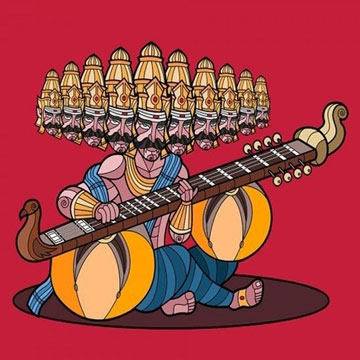 New Delhi:
New Delhi: The celebration of Dussehra revolves around a common belief - that Ravana embodied the ills of this world and burning his effigy is symbolic of burning away of those evils. The Ramayana, too, is essentially a tale of good winning over evil.
This begs the question - is reality truly as black and white as that?
To blame, perhaps, is our inflexible understanding of good and bad. We often become unaccepting of anything that stands firmly in the centre, of things which are not essentially right or wrong, good or bad, but just grey.
The popular version of the Ramayana depicts Ravana as a uni-dimensional character, an anti-hero, blinded by revenge and lust and bereft of nuances. That simplified and condensed version is the one we pass on to our children.
Yet, there are some exceptions. Some versions of the epic treat the character of Ravana differently. Even though the modifications may seem slight, their implications are vast.
This dichotomy is obvious in the description of Sita's abduction. In the Valmiki Ramayana, Ravana physically drags Sita away, while in the Kamba Ramayana, he lifts the hut Sita is in, with all the earth underneath it, and thereby, does not touch her.
The Kamba Ramayana is also slightly more charitable to the character of Ravana and does describe him as a great and just ruler to his people.
Ravana worship is not as rare or unheard of as people may believe. For years, districts in Madhya Pradesh have refrained from 'celebrating' Dussehra. They do not burn Ravana effigies and instead worship him as a man of great knowledge and wisdom. So much so, they even avoid looking at Ravan-dahan, let alone do it. Ravana is especially accorded great respect in Mandsaur district, where he is hailed as the town's son-in-law. It is said his wife Mandodari belonged to the area.
Amravati's tribal population, too, venerates Ravana as a deity. They seek his blessings and take out rallies in respect of him, his son Meghnad and Dai Kali Kankali.
There are several Ravana temples all over India. Many of these temples are replete with idols of Ravana, often in his ten-headed form.
In fact, it is not just strands of Hindu tradition, but also the Jain faith that anticipates the greatness of the Ramayana's anti-hero.
A Times of India article from 2011 brings to the fore the belief that Ravana will be one of the 24 tirthankaras in the next cycle, expected to come into force in roughly 84,000 human years.
Him and the 23 other future tirthankaras are still believed to be trapped in the cycle of birth and death. "When they receive enlightenment, all the world will know. There will be no illness or drought for miles from the place they are born, all species will be able to hear and understand them, a throne will magically emerge, there will be a shower of flowers and an aura will circle their heads," says Jain monk Masatiji Bhavyaratna. "We don't worship Ravana today, because, for us, he has still not received enlightenment or shed his bow and arrow."
According to Encyclopedia Britannica, Ravana has also been significant in the South's opposition to the North India's cultural domination. Some Tamil groups saw Ram as a symbol of Sanskritization and hence, treated him with some amount of hostility.
A pioneering attempt was made by Anand Neelkantan in his book 'Asura' wherein he attempted to change the perception of Ravana as expressed in the popular narrative.
How successful this attempt was only time will tell. Yes, Ravana's abduction of Sita cannot be justified. But it seems incorrect to simply gloss over the just king, unwavering devotee, and brilliant warrior.#Source: ToI
 New Delhi: The celebration of Dussehra revolves around a common belief - that Ravana embodied the ills of this world and burning his effigy is symbolic of burning away of those evils. The Ramayana, too, is essentially a tale of good winning over evil.
New Delhi: The celebration of Dussehra revolves around a common belief - that Ravana embodied the ills of this world and burning his effigy is symbolic of burning away of those evils. The Ramayana, too, is essentially a tale of good winning over evil.